NVIDIA GeForce GTX 690 Review: Ultra Expensive, Ultra Rare, Ultra Fast
by Ryan Smith on May 3, 2012 9:00 AM ESTCrysis: Warhead
Kicking things off as always is Crysis: Warhead. It’s no longer the toughest game in our benchmark suite, but it’s still a technically complex game that has proven to be a very consistent benchmark. Thus even four years since the release of the original Crysis, “but can it run Crysis?” is still an important question, and the answer when it comes to setups using a pair of high-end 28nm GPUs is “you better damn well believe it.”
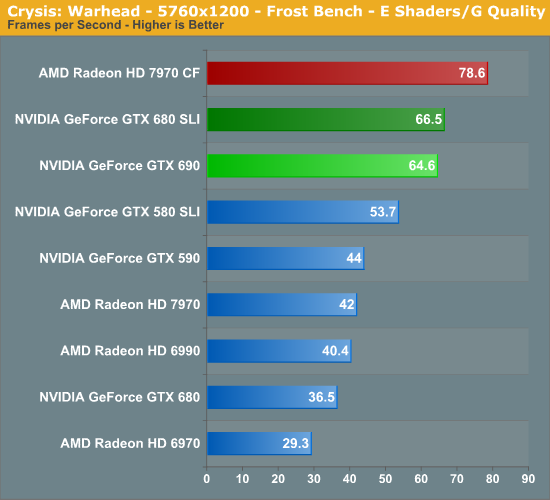
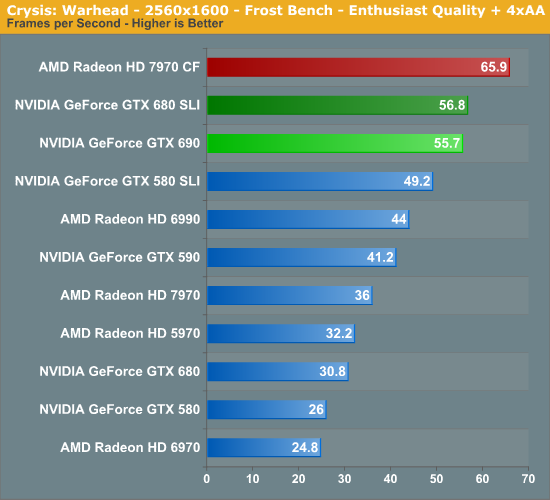
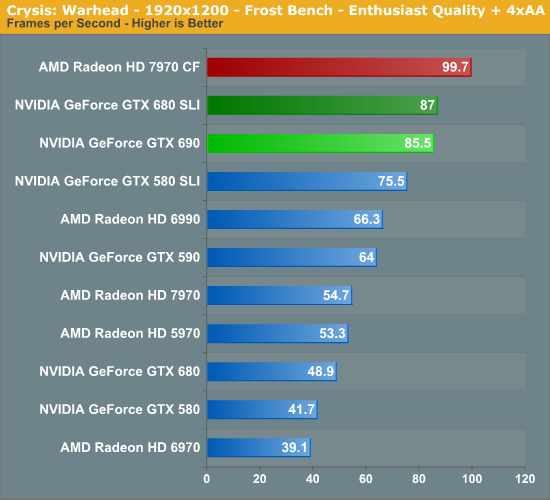
Crysis was a game that Kepler didn’t improve upon by a great deal compared to the Fermi based GTX 580. NVIDIA sees some good SLI scaling here, but AMD’s performance lead with a single GPU translates into an equally impressive lead with multiple GPUs; in spite of all of its capabilities the GTX 690 trails the 7970CF by 18% here. So long as AMD gets good Crossfire scaling here, there’s just no opening for Kepler to win, allowing AMD to handily trounce the GTX 690 here.
As for the intra-NVIDIA comparisons, the GTX 690 does well for itself here. Performance relative to the GTX 680 SLI at 2560 is 98%, which represents a 77% lead over the GTX 680. Overall performance is quite solid; at 55.7fps we’re nearly to 60fps on Enthusiast quality at 2560 with 4x MSAA, which is the holy grail for a video card. Even 5760 is over 60fps, albeit at lower quality settings and without AA.
It’s taken nearly 4 years, but we’re almost there; Crysis at maximum on a single video card.
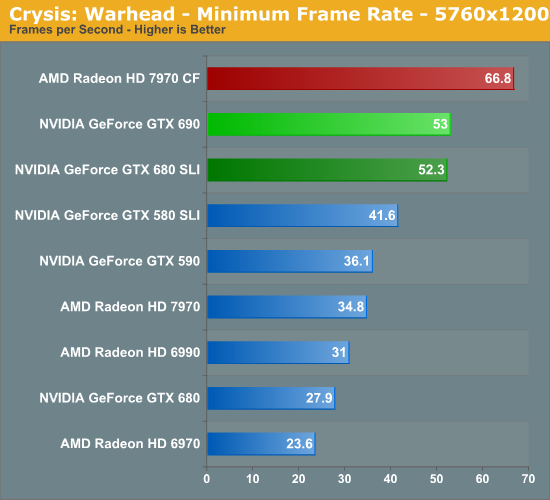

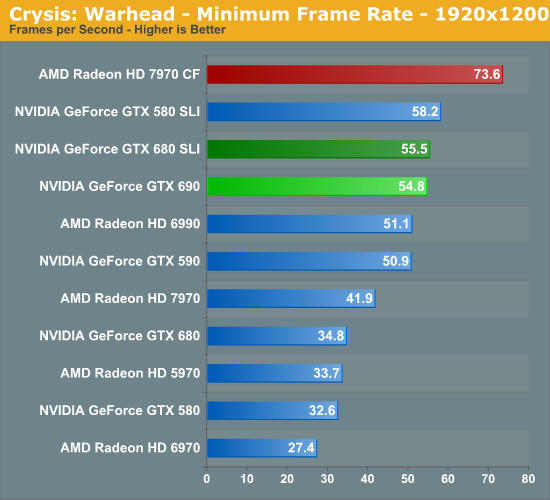
Our minimum framerates are much the same story for NVIDIA. The GTX 690 once again just trails the GTX 680 SLI, while interestingly enough the dual-GPU NVIDIA solutions manage to erode AMD’s lead at a single point: 2560. Here they only trail by 8%, versus 20%+ at 5760 and 1920. Though at 1920 we also see another interesting outcome: the GTX 580 SLI beats the GTX 680 SLI and GTX 690 in minimum framerates. This would further support our theory that the GTX 680 is memory bandwidth starved in Crysis, especially at the lowest performance points.










200 Comments
View All Comments
tviceman - Thursday, May 3, 2012 - link
Last page: Based on our benchmarks we’re looking at 95% of the performance of the GTX "580 SLI" - 580 SLI should read 680 SLI.UltraTech79 - Thursday, May 3, 2012 - link
I wish there was a separate button to point out this sort of thing so they could silently correct it. Dont get me wrong, I think its good to have accurate information, just clutters things up a bit.Ryan Smith - Thursday, May 3, 2012 - link
My inbox is always open.=)mediaconvert - Friday, May 4, 2012 - link
p 2While the basic design of the GTX 690 resembles the GTX 590, NVIDIA has replaced virtually every bit "with plastic with metal" for aesthetic/perceptual purposes.
surely "with plastic with metal" to "of plastic with metal"
still a good review
rockqc - Thursday, May 3, 2012 - link
1st line on page 2 "Much like the GTX 680 launch and the GTX 590 before it, the first generation the first generation of GTX 690 cards are reference boards being built by NVIDIA"First generation has been written twice.
Torrijos - Thursday, May 3, 2012 - link
The first benchmark plotted (Crysis) has a resolution of 5760 x 1200, this has to be wrong!tipoo - Thursday, May 3, 2012 - link
It's crazy but right. He tested that resolution on multiple games.CeriseCogburn - Thursday, May 3, 2012 - link
If you look at accumulated benchmarks across the web, the 680 Nvidia cards beat the 7970 amd cards by a much higher percentage in 1920x1080 (17.61% ahead) than they do in 1920x1200 (10.14% ahead).This means anand reviews always tests in 1920x1200 to give the amd cards a prettier looking review, instead of testing in 1920x1080 (the most commonly available resolution at 1920x that they could easily set their 1920x1200 monitors to).
Hence their tests here at anand are likely also amd favorably biased in higher resolutions.
http://translate.google.pl/translate?hl=pl&sl=...
A5 - Thursday, May 3, 2012 - link
It's not like 19x12 is an uncommon or unavailable resolution. Maybe Nvidia should improve their 19x12 performance?crimson117 - Thursday, May 3, 2012 - link
Sadly, it is a very uncommon resolution for new monitors. Almost every 22-24" monitor your buy today is 1080p instead of 1200p. :(